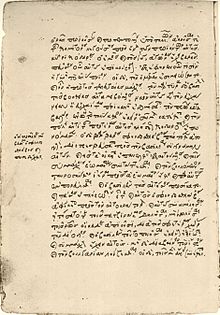Johannes Zonaras

Johannes Zonaras ( Middle Greek Ἰωάννης Ζωναράς ) was a Byzantine historian , canonist and lawyer of the 12th century.
Only what he says about the life of Johannes Zonaras in his works is known. In research it is mostly assumed that under the Byzantine emperor Alexios I (1081–1118) he was the commander of the bodyguard and head of the imperial chancellery, as he himself claims.
Among other things, Zonaras wrote a commentary on the canons , the ecumenical and local synods received by Orthodoxy , and on the canons of the Church Fathers . There are also two smaller canonical writings. In addition, the Zonarae Lexicon was often wrongly ascribed to him, a Byzantine lexicon of the 13th century written by several monks.
His main work is a historical work entitled Epitome Historion ("Summary of History"). It is a world chronicle that goes from the creation of the world to the year 1118. The epitome , which represents one of the most comprehensive historical works in the Greek language and was written in a clear style, was created by Zonaras after his retreat into private life (this was possibly due to the accession of John II Comnenus to the throne ) and his exile as a monk in the monastery on the Hagia Glykeria Island . In a preface he justifies himself for being a monk as a writer. In doing so, he initially appeals to the invitation of friends and at the same time sees literary activity as a good distraction from the lure of earthly existence. Unlike many of his contemporaries, Zonaras did not succeed in slipping too much into theology. Nevertheless, the author orients himself in the division of his work on religion: the first part covers the Jewish, the second the Roman-Christian period.
In his description, Zonaras sometimes used sources that are no longer preserved today (see also Leo spring ), which gives his presentation additional value. His intention was not (as he explains in the prologue of his work) originality, rather he wanted the history to be summarized in the form of a manual ( epitome ), focused on the facts and presented clearly, whereby he partially abbreviated and summarized material from the sources he used, but otherwise reproduced the content-related statements. In Zonaras there are also traces of works by pagan (pagan) authors that have not come down to us. Due to the loss of several ancient historical works, his work is a not unimportant source , especially for the history of the imperial crisis of the 3rd century , but also in part for late ancient history . In addition, the epitome is important for the reconstruction of the content of the Roman history of Cassius Dio , since Zonaras used Dio's work extensively.
The current division follows that of the French Byzantinist Charles du Fresne, sieur du Cange (1610–1688), into eighteen books. In books 1–12, world history from creation to tetrarchy is compiled . Books 13-18 deal with the Byzantine history from Constantine the Great to the death of Alexios I Komnenus in 1118.
Editions and translations
- Editio princeps: Ioannis Zonarae Monachi, qui olim Byzantii Magnus Drungarius excubiaru [m] seu Biglae, & protosecretarius fuit, compendium Historiarum: in tres Tomos distinctum . 3 volumes, Greek-Latin parallel text. Oporinus, Basel 1557. Vol. 1 Vol. 2 Vol. 3 (Digital collections of the Bayer. Staatsbibl.)
- Ioannis Zonarae epitome historiarum (= Corpus Scriptorum Historiae Byzantinae 50). Edited by M. Pinder and Th. Büttner-Wobst . 3 volumes. Weber, Bonn 1841ff.
- Ioannis Zonarae epitome historiarum. Published by Ludwig Dindorf . 6 volumes. Teubner, Leipzig 1868–1875.
- Thomas M. Banchich, Eugene N. Lane (translator): The History of Zonaras. From Alexander Severus to the Death of Theodosius the Great. Introduction and commentary by Thomas M. Banchich. Routledge, London et al. 2009, ISBN 978-0-415-29909-1 (English partial translation with introduction and commentary).
- Erich Trapp (translator): Military and courtiers in the struggle for the empire. Byzantine history from 969 to 1118 (= Byzantine historians 16). Translated, introduced and explained. Styria, Graz et al. 1986, ISBN 3-222-10295-3 (translation of books 17 and 18).
literature
- Bruno Bleckmann : The Imperial Crisis of III. Century in late antique and Byzantine historiography. Investigations on the post-Dionic sources of the Chronicle of Johannes Zonaras (= sources and research on the ancient world 11). tuduv-Verlags-Gesellschaft, Munich 1992, ISBN 3-88073-441-0 (also: Cologne, Univ., Diss., 1991).
- Iordanis Grigoriadis: Linguistic and literary studies in the "Epitome historion" of John Zonaras (= Byzantina keimena kai meletai 26, ZDB -ID 420491-8 ). Kentro Byzantinon Ereunon, Thessaloniki 1998.
- Herbert Hunger : The high-level profane literature of the Byzantines (= Handbook of Classical Studies . Department 12: Byzantine Handbook. Part 5). Volume 1: Philosophy, Rhetoric, Epistolography, Historiography, Geography. Beck, Munich 1978, ISBN 3-406-01427-5 .
- Enrico V. Maltese: Zonaras, Johannes. In: Lexicon of the Middle Ages . Volume 9, Col. 673f.
- Warren Treadgold : The Middle Byzantine Historians . Palgrave Macmillan, Basingstoke 2013, p. 388ff.
Web links
- Literature by and about Johannes Zonaras in the catalog of the German National Library
Remarks
- ↑ This represents the general research opinion, cf. Introduction in Banchich, The History of Zonaras , pp. 2ff. as well as Maltese, Zonaras, Johannes ; deviating from this Klaus-Peter Todt: Zonaras, Johannes. In: Biographisch-Bibliographisches Kirchenlexikon (BBKL). Volume 14, Bautz, Herzberg 1998, ISBN 3-88309-073-5 , Sp. 579-584.
- ↑ See generally Hunger: Literatur. Vol. 1, p. 416ff.
- ↑ Banchich: The History of Zonaras , pp. 8f.
- ↑ Cf. for example: Bruno Bleckmann : The Chronicle of Johannes Zonaras and a pagan source on the history of Constantine. In: Historia . 40, 1991, pp. 343-365.
- ↑ See above all Bleckmann: Reichskrise .
| personal data | |
|---|---|
| SURNAME | Zonaras, Johannes |
| ALTERNATIVE NAMES | Ἰωάννης Ζωναράς (Greek); Ioannis Zonaras (Latin) |
| BRIEF DESCRIPTION | Byzantine historian and lawyer |
| DATE OF BIRTH | 12th Century |
| DATE OF DEATH | 12th Century |